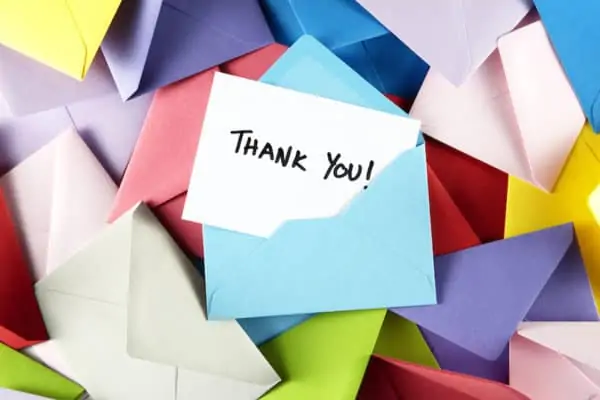We all need a little help in school (and life). Showing appreciation for all our parents and friends have done for us usually happens casually, whether it be a simple “thank you,” returning the favor, or another gesture. But what about those times where a little formality is needed?
Like thanking your teacher for writing you a letter of recommendation. Or following up after a job interview. Or when you’ve conducted an informational interview with a professional. Or showing appreciation to anyone who’s ever give you guidance, time, or resources. Each of these instances should be followed up with a thank you note.
Most of us have busy lives and if someone donates a portion of their day to you, it’s only polite to repay them with a small note of thanks. With the five simple steps below, you can be sure to create thank you notes that leave a great impression.
Then, make sure your letter is polished and professional (not to mention free of embarrassing typos) by running it through our online grammar checker!
Step 1: Choose Your Medium
Nowadays email is the most common medium for sending thank you notes. It’s fast and professional. There are instances, however, when you should consider sending a handwritten message on stationery. If someone has gone above and beyond for you or if your relationship is more personal than average (for example, a very good friend of your parents), a handwritten note can be a nice touch.
Step 2: Craft Your Opening Line
Resist the urge to get too creative with your letter opening. Thank you notes are very traditional. Following classic form demonstrates maturity and poise. “Dear” is the appropriate salutation. Be sure to actually write “thank you” and simply follow up with what you are thanking the individual for.
Example:
- Dear Helen,
- Thank you for…
- meeting with me yesterday.
- the great informational interview
- taking the time to speak with me over the phone yesterday.
- donating to our student fundraiser.
Step 3: Make It Personal
This is your chance to shine and show your personality. Highlight something specific you spoke about. If this is a note following a job interview, it the right place to reiterate your interest in the position and your unique qualifications for it. Three or four sentences is a good target for this section.
Examples:
- It was great speaking with a fellow New Yorker.
- I never knew how much goes into pricing a garment.
- Your ideas on diversity in the workplace were inspirational.
- The opportunity to intern with you and learn more would be amazing.
Step 4: Closing
Your closing should be short and simple. Reiterate your thanks, add another sentence if you wish and choose one of the well known closing phrases listed below.
Examples:
- Thank you again,
- I look forward to speaking with you soon.
- Your advice was invaluable.
- Regards,
- Best Regards,
- Sincerely,
Step 5: Proofread
A thank you note is often your final chance to make an impression. Be sure a typo is not the last thing you are remembered for. Most importantly, double check the name of the person and institution you are sending the note to.
If you’re looking for extra help, there are many great grammar and spell checker services online.
Quick Tips:
- Don’t make your note too long. Three short paragraphs are enough.
- Don’t be overly complimentary. It often turns people off, especially if you don’t know them very well.
- Don’t procrastinate. The following day is best; anything over a week is much too long.
Your final note should look something like this:
Dear Helen,
Thank you for meeting with me yesterday.
You taught me a lot about the fashion industry behind the scenes. I never knew how much goes into pricing a garment. The opportunity to intern with you and learn more would be amazing.
Thank you again for taking the time to speak with me. I look forward to hearing from you soon.
Best Regards,
Kristen
Thank you notes are easy, polite, and a way to show your best side. All you have to do is keep it simple.
If you’re worried about punctuation, subject verb agreement, and overall good grammar, try BibMe Plus. You can check your letter or paper for grammar and spelling mistakes as well as automatically create a works cited page in MLA, an APA format citation, or references in thousands of styles.

